D Link WA182D1 AC1200 MU-MIMO Wi-Fi USB Adapter User Manual
D-Link Corporation AC1200 MU-MIMO Wi-Fi USB Adapter
D Link >
User Manual

DWA-182
User Manual
Version 4.01 | 10/12/2017
AC1200 MU-MIMO Wi-Fi USB Adapter

2D-Link DWA-182 User Manual
Table of Contents
Product Overview .............................................................. 3
Package Contents .........................................................................3
System Requirements ................................................................. 3
Introduction ................................................................................... 4
Features ............................................................................................5
Hardware Overview .....................................................................6
Installation ......................................................................... 7
Getting Started ..............................................................................7
Remove Existing Installations ..........................................7
Disable Other Wireless Adapters .....................................8
Wireless Installation Considerations ....................................10
Adapter Installation ...................................................................11
Connect to a Wireless Network .............................................14
Windows® 10 ................................................................................14
Windows® 8.1/ Windows 8 ......................................................16
Windows® 7 ................................................................................... 18
Wireless Security .............................................................19
What is WPA™? ..............................................................................19
Troubleshooting ..............................................................20
Wireless Basics .................................................................24
Wireless Modes ............................................................................28
Networking Basics ...........................................................29
Check your IP address ...............................................................29
Statically Assign an IP address ...............................................30
Technical Specications ..................................................31
Warranty ...........................................................................32
Table of Contents

3D-Link DWA-182 User Manual
Section 1 - Product Overview
D-Link DWA-182 AC1200 MU-MIMO Wi-Fi USB Adapter
USB 3.0 Cable (only available in some regions)
CD with drivers and software
System Requirements
• A computer or laptop with an available USB 2.0 or USB 3.0 port
• Windows® 10/ 8.1/ 8/ 7, Vista or XP (Service Pack 3)
• CD-ROM Drive
• A 802.11ac, 802.11n, 802.11g or 802.11a access point or wireless router
Product Overview
Package Contents

4D-Link DWA-182 User Manual
Section 1 - Product Overview
Introduction
The AC1200 MU-MIMO Wi-Fi USB Adapter (DWA-182) delivers powerful wireless AC technology to your desktop or notebook computer. Simply plug
the adapter into an available USB port and connect to a wireless network to access a secure, high-speed internet connection – 2.4GHz (300Mbps)
or 5GHz (up to 867Mbps). And with integrated Dual Band technology, you’ll have reduced Wi-Fi interference to maximize throughput for faster
streaming, gaming, and Skype calls.
Interference-Free Bandwidth
The AC1200 MU-MIMO Wi-Fi USB Adapter (DWA-182) delivers Dual Band technology to your home network for intelligent, versatile, interference-
free bandwidth. Check your email and surf the Internet on the 2.4GHz band; or game, make Skype calls and stream HD movies to multiple devices
using the cleaner, interference-free 5GHz band. Whatever you like to do online, Dual Band has you covered.
Easy WPS Push Button Setup
Quickly and easily establish a fast, secure home network that will have you browsing, streaming, and watching in minutes. It’s as easy as push and
connect!
Compatible With All Your Wireless Products
While the AC1200 MU-MIMO Wi-Fi USB Adapter delivers cutting-edge 802.11ac speed to your home network, it’s also backward compatible with
all of your current wireless products – no updates or adapters necessary.
What is wireless AC?
802.11ac is a new networking standard that produces high-throughput wireless speed on the 5GHz band. What does this mean for your home
network? Flawless HD video streaming, faster gaming, and lag-free Skype and Facetime calls, all with less Wi-Fi interference for smooth, lightning-fast
performance. And while your home gains all the cutting-edge bene ts of 11ac, D-Link’s AC1200 MU-MIMO Wi-Fi USB Adapter is also compatible
with all of your current Wireless N products.
“Maximum wireless signal rate derived from IEEE 802.11ac specication and IEEE Standard 802.11n specication. D-Link makes no warranties as to forward compatibility with future standards or compatibility with 802.11ac
devices from other manufacturers. Actual data throughput will vary. Network conditions and environmental factors, including volume of network trac, building materials and construction, and network overhead,
lower actual data throughput rate. Environmental factors may adversely aect wireless signal range. Up to 867Mbps wireless speeds achieved when connecting to other 802.11ac devices. Data throughput may also be
limited by the product’s interface, less than 480 Mbps for a USB 2.0 interface. The inclusion of a specic product or manufacturer does not imply its endorsement of D-Link or the D-Link product. Computer must adhere
to Microsoft’s recommended System Requirements.”

5D-Link DWA-182 User Manual
Section 1 - Product Overview
Features
• IEEE 802.11ac, 802.11n, 802.11g and 802.11a Compliant
• Dual Band N Technology for use in 2.4GHz or 5GHz Networks
• Wireless AC Wave 2 Technology for Superior Wireless Performance
• Access Secure Networks using WPA™ or WPA2™
• Wi-Fi Protected Setup™ (WPS) Push Button for Easy Connection to a Wireless Network
• USB* Extension Cable for Placement Flexibility
* Using a USB 1.1 port will adversely aect throughput.
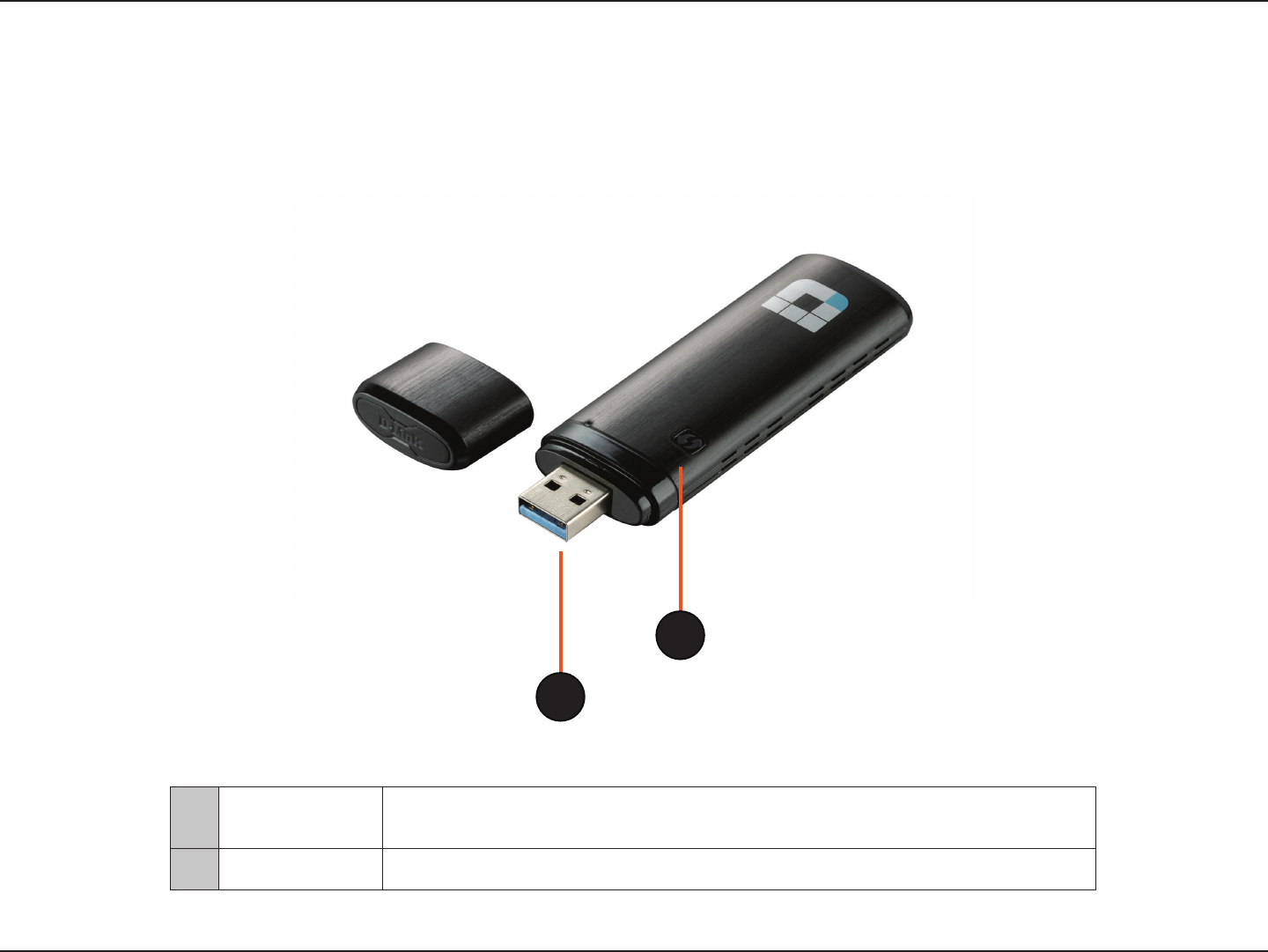
6D-Link DWA-182 User Manual
Section 1 - Product Overview
Hardware Overview
1WPS Button Press the WPS button to automatically connect to a WPS-enabled wireless router
or access point and establish connectivity. Refer to “Push Button” on page 13
2USB Connector Used to connect the DWA-182 to your computer.
1
2

7D-Link DWA-182 User Manual
Section 2 - Installation
Installation
This section will walk you through the installation process. If you have a built-in wireless adapter, please disable it in device manager before installing
your D-Link adapter. Also, if you have previously installed another wireless adapter, please make sure any software is uninstalled.
Getting Started
Before installing your new D-Link wireless adapter, please verify the following:
• Remove any previous installations of wireless adapters
• Disable any built-in wireless adapters
• Verify the settings such as the SSID and security settings of the network(s) you want to connect to
Remove Existing Installations
If you’ve installed a dierent manufacture’s adapter or a dierent model D-Link adapter, make sure the software is uninstalled before installing
the new software. Some utilities may cause a conict with the new software. If you plan to use multiple adapters at dierent times, make sure the
utilities are not set to load when your computer boots up.
To remove any old software:
Windows 10 users: Click Start > All apps > Windows System > Control Panel > Programs > Uninstall a Program
Windows 7/8 users: Click Start > Control Panel > Uninstall Programs.
Windows Vista®/XP users: Click Start > Control Panel > Add or Remove Programs.
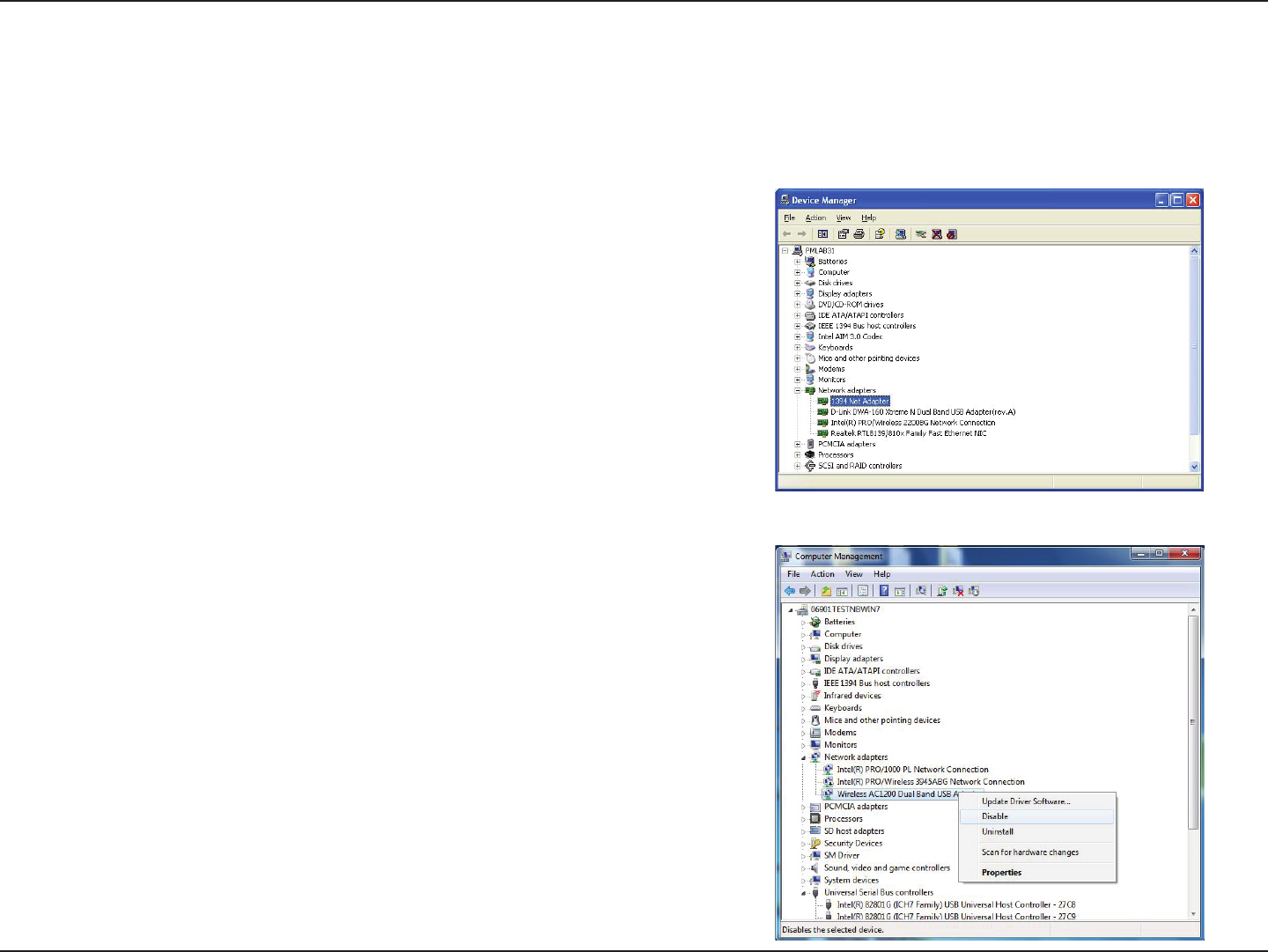
8D-Link DWA-182 User Manual
Section 2 - Installation
Disable Other Wireless Adapters
Most newer laptops may include a built-in wireless adapter. To prevent any conicts with the D-Link wireless adapter, it is recommended to disable
the wireless adapter (as well as any unused Ethernet adapters).
From the desktop, right-click on the My Computer icon and select Properties.
Click the Hardware tab and then click Device Manager. Scroll down the list and click the
+ sign to the left of Network Adapters.
Right-click the adapter you would like to disable and select Disable.

9D-Link DWA-182 User Manual
Section 2 - Installation
Click Yes to disable the adapter.
When the adapter is disabled, a down arrow or a grayed icon will be displayed.
Disabling the adapter will not remove the drivers. If you would like to use the
adapter, simply right-click it and select Enable.

10D-Link DWA-182 User Manual
Section 2 - Installation
Wireless Installation Considerations
The D-Link wireless adapter lets you access your network using a wireless connection from virtually anywhere within the operating range of your
wireless network. Keep in mind, however, that the number, thickness and location of walls, ceilings, or other objects that the wireless signals must
pass through, may limit the range. Typical ranges vary depending on the types of materials and background RF (radio frequency) noise in your
home or business. The key to maximizing wireless range is to follow these basic guidelines:
1. Keep the number of walls and ceilings between the D-Link adapter and other network devices to a minimum - each wall or ceiling
can reduce your adapter’s range from 3-90 feet (1-30 meters.) Position your devices so that the number of walls or ceilings is
minimized.
2. Be aware of the direct line between network devices. A wall that is 1.5 feet thick (.5 meters), at a 45-degree angle appears to be
almost 3 feet (1 meter) thick. At a 2-degree angle it looks over 42 feet (14 meters) thick! Position devices so that the signal will
travel straight through a wall or ceiling (instead of at an angle) for better reception.
3. Building materials make a dierence. A solid metal door or aluminum studs may have a negative eect on range. Try to position
access points, wireless routers, and computers so that the signal passes through drywall or open doorways. Materials and objects
such as glass, steel, metal, walls with insulation, water (sh tanks), mirrors, le cabinets, brick, and concrete will degrade your
wireless signal.
4. Keep your product away (at least 3-6 feet or 1-2 meters) from electrical devices or appliances that generate RF noise.
5. If you are using 2.4GHz cordless phones or X-10 (wireless products such as ceiling fans, lights, and home security systems), your
wireless connection may degrade dramatically or drop completely. Make sure your 2.4GHz phone base is as far away from your
wireless devices as possible. The base transmits a signal even if the phone in not in use.
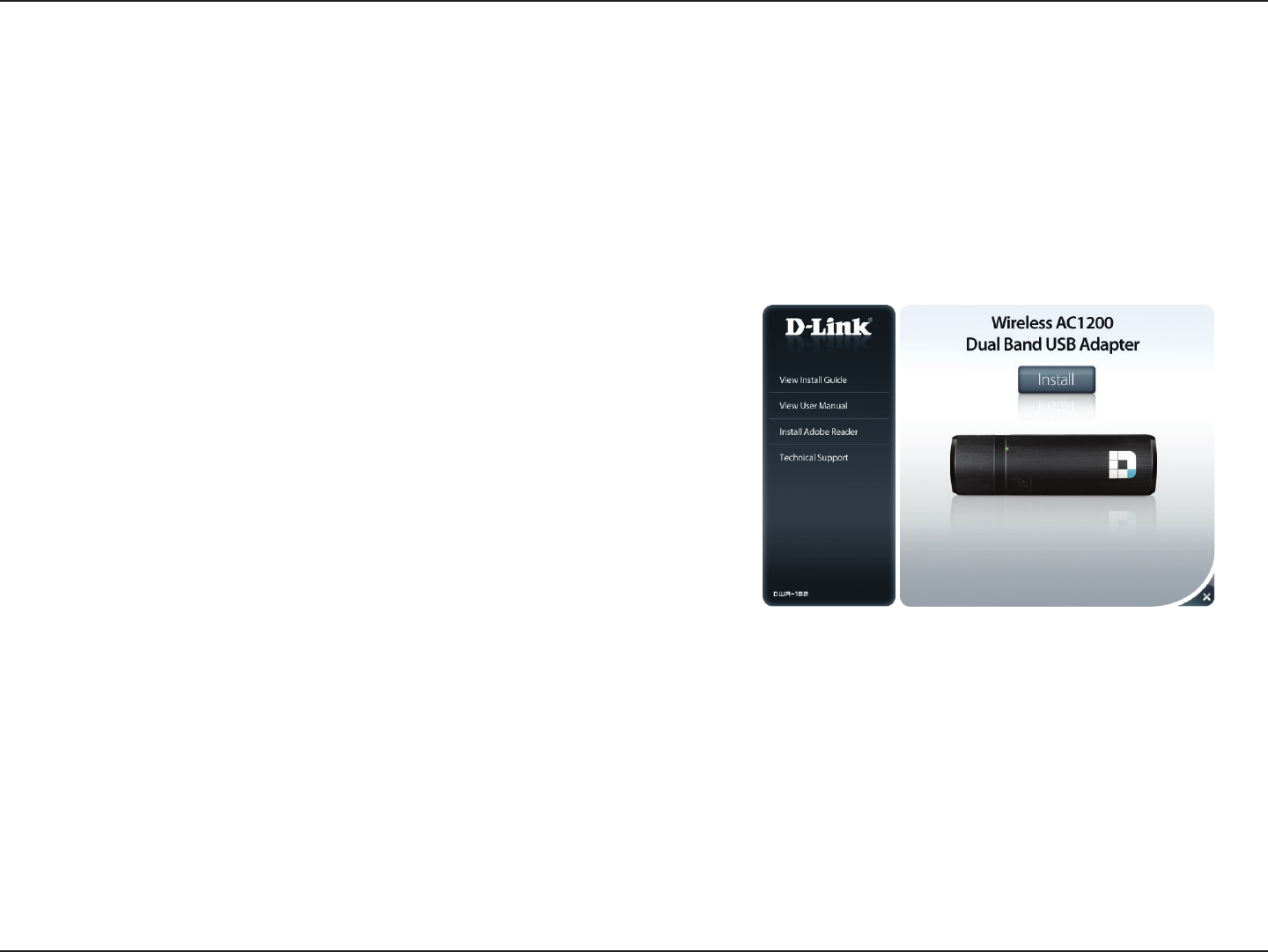
11D-Link DWA-182 User Manual
Section 2 - Installation
Warning: Do NOT install the DWA-182 adapter into your computer before installing the driver software from the D-Link CD.
Turn on the computer and Insert the D-Link DWA-182 Driver CD in the CD-ROM drive.
If the CD Autorun function does not automatically start on your computer, go to Start > Run. In the run box type “D:\autorun.exe” (where D:
represents the drive letter of your CD-ROM drive).
When the autorun screen appears, click Install.
Adapter Installation
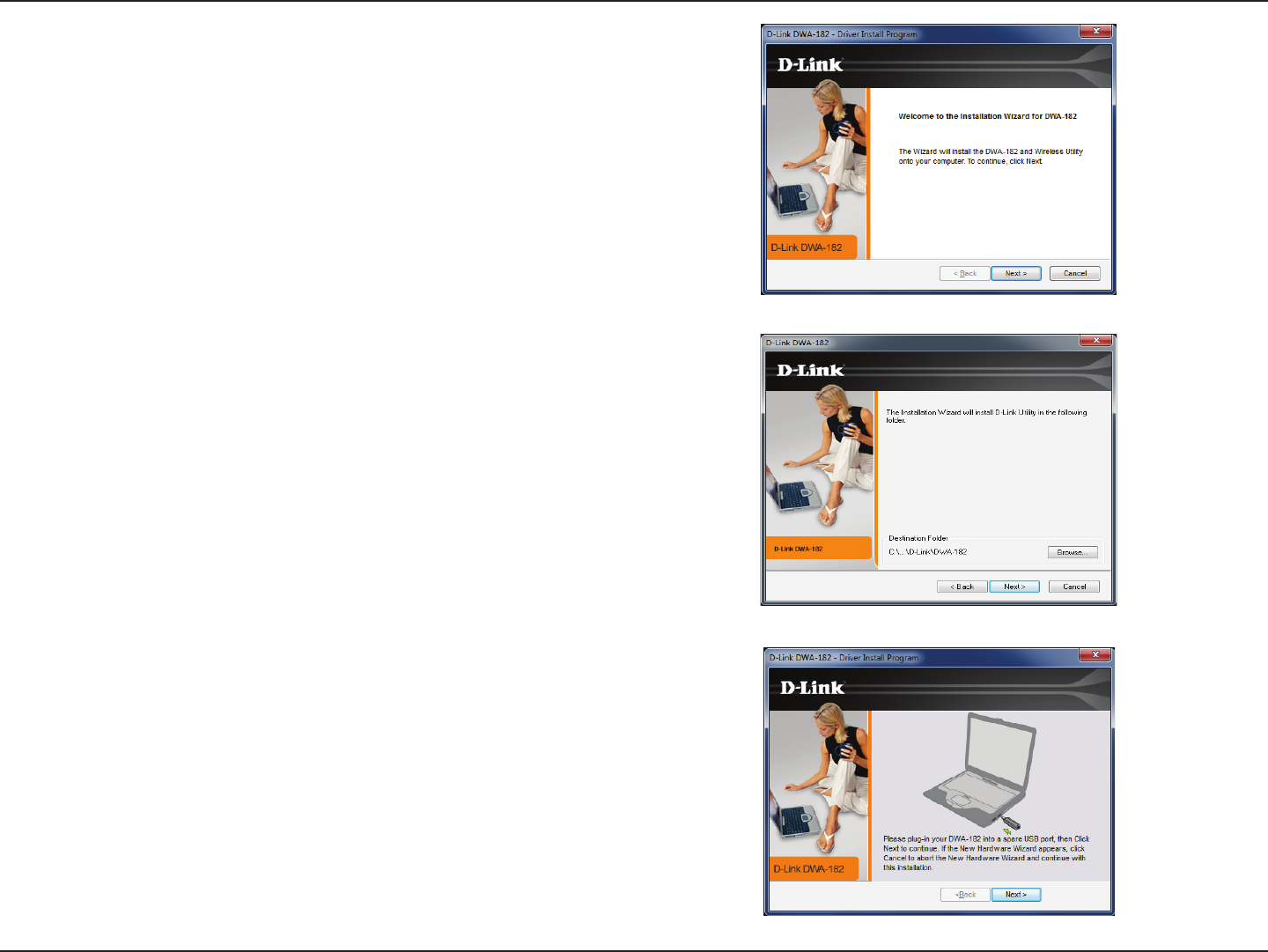
12D-Link DWA-182 User Manual
Section 2 - Installation
The welcome window will appear. Click Next to continue.
By default setup will install to the default location: C:\Program Files\D-Link\
DWA-182, where C: represents the drive letter of your hard drive.
Insert the adapter into an available USB port on your computer. Click Next to
continue.
If the Found New Hardware Wizard appears, click Cancel.

13D-Link DWA-182 User Manual
Section 3 - Conguration
Push Button
1. To connect to your network, press the WPS button on the adapter
and hold for two seconds until the wizard screen appears.
2. Press the WPS button located on your access point or router to
continue. This screen will appear once you have successfully
established connection with your network.
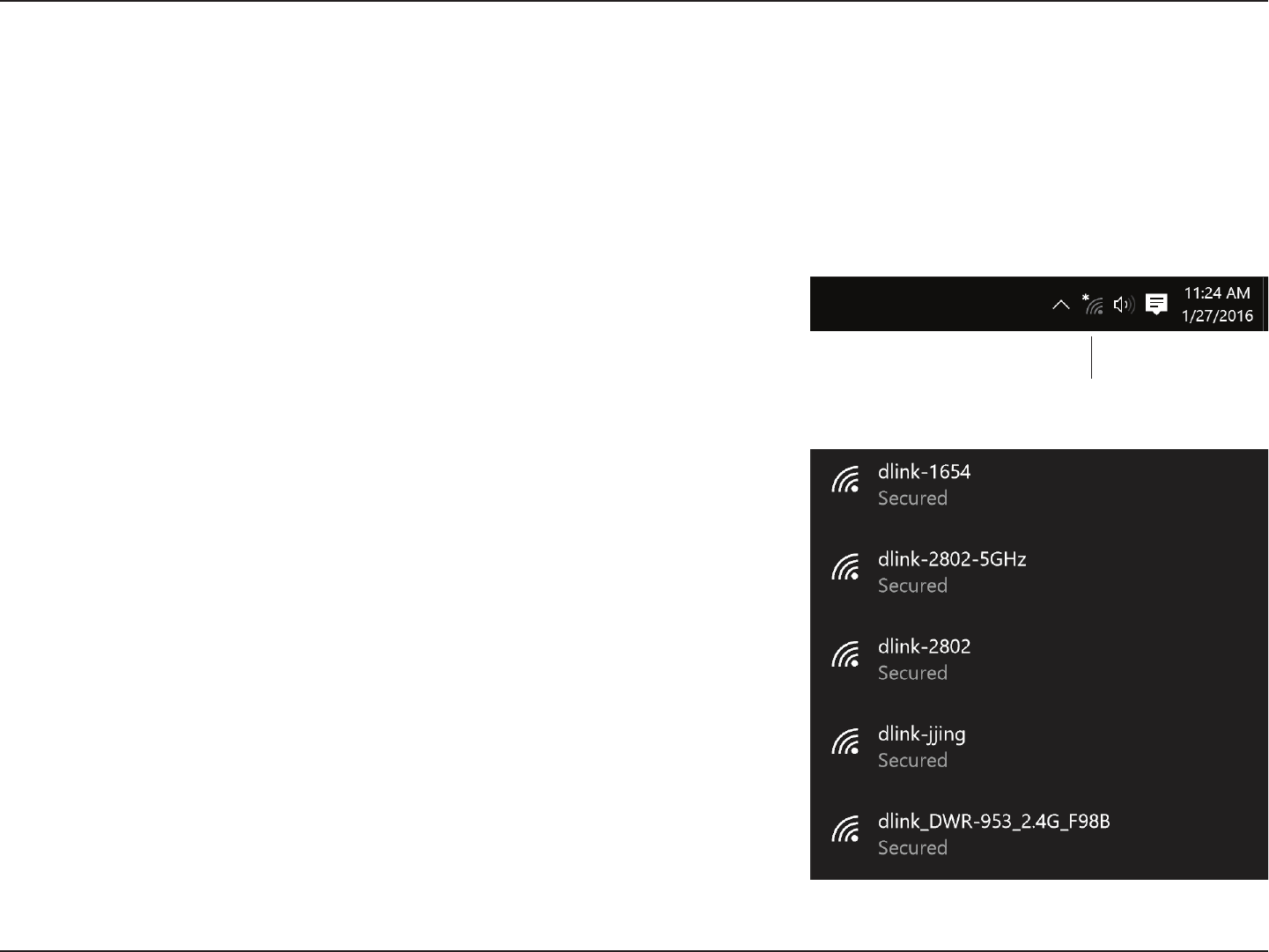
14D-Link DWA-182 User Manual
Section 4 - Connect to a Wireless Network
To connect to a wireless network using Windows 10, you will need to know the wireless network name (SSID) and Wi-Fi password (security key) of
the device you are connecting to.
To join an existing network, locate the wireless network icon in the taskbar, next to the time
display and click on it.
Wireless Icon
Clicking on this icon will display a list of wireless networks which are within range of your
computer. Select the desired network by clicking on its SSID.
Connect to a Wireless Network
Windows® 10

15D-Link DWA-182 User Manual
Section 4 - Connect to a Wireless Network
To connect to the network, click Connect.
To automatically connect when your device is in range, click the Connect Automatically
check box. Your computer will now automatically connect to this wireless network whenever
it is detected.
You will then be prompted to enter the Wi-Fi password (network security key) for the wireless
network. Enter the password into the box and click Next to connect to the network.
You can also use Wi-Fi Protected Setup (WPS) to connect to the wireless network. Press the
WPS button on your device and you will be automatically connected.
It may take 20-30 seconds to connect to the wireless network. If the connection fails, please
verify that the security settings are correct. The key or passphrase must be exactly the same
as the one on the wireless router.
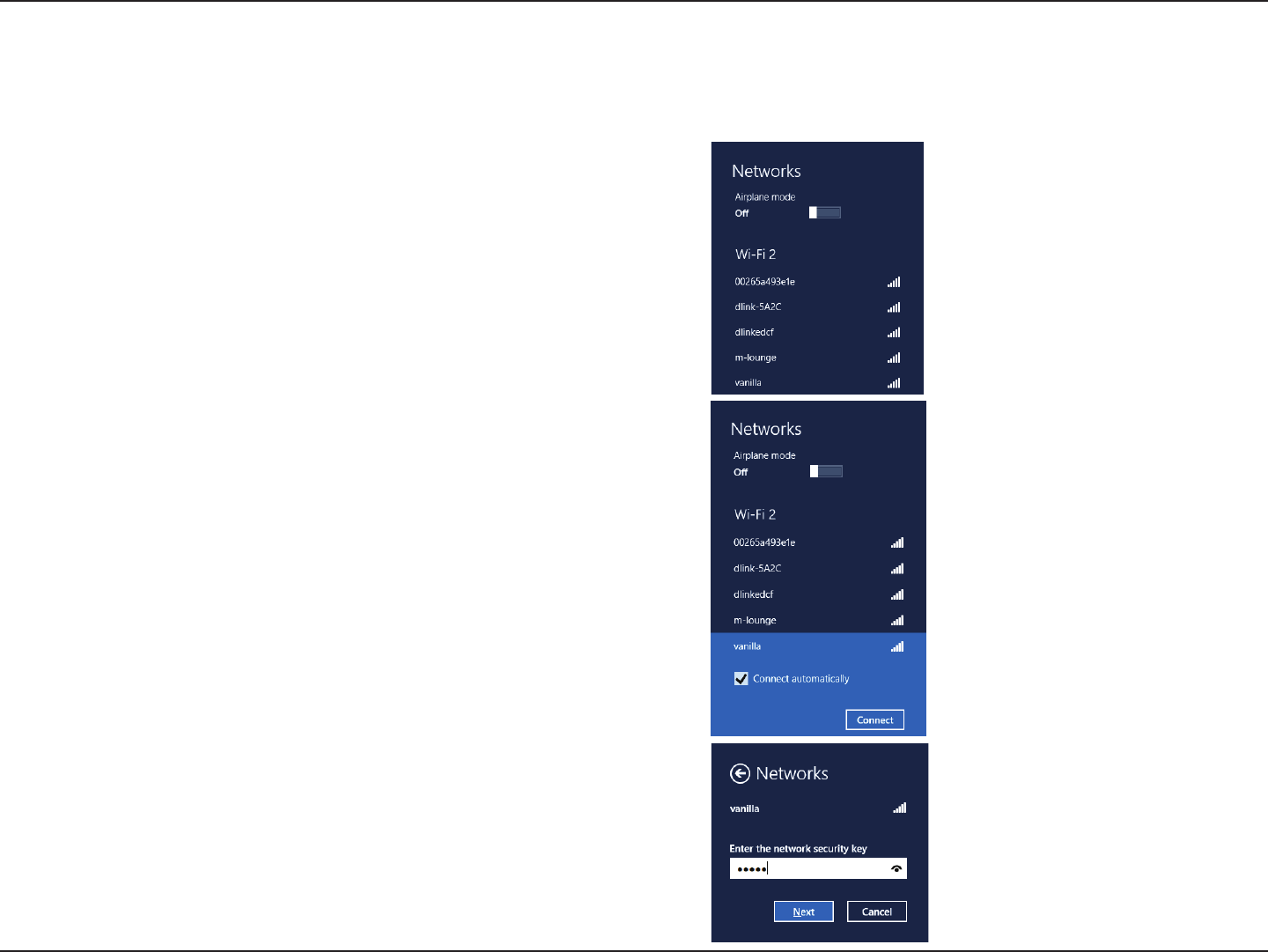
16D-Link DWA-182 User Manual
Section 4 - Connect to a Wireless Network
Windows® 8.1/ Windows 8
1. Click on the wireless computer icon in your system tray (lower-right corner
next to the time).
2. A list of available wireless networks will appear.
3. Click the wireless network (SSID) you want to connect to and then click
Connect.
4. If the network is secure/encrypted, enter the Wi-Fi password (security key)
and click Next.
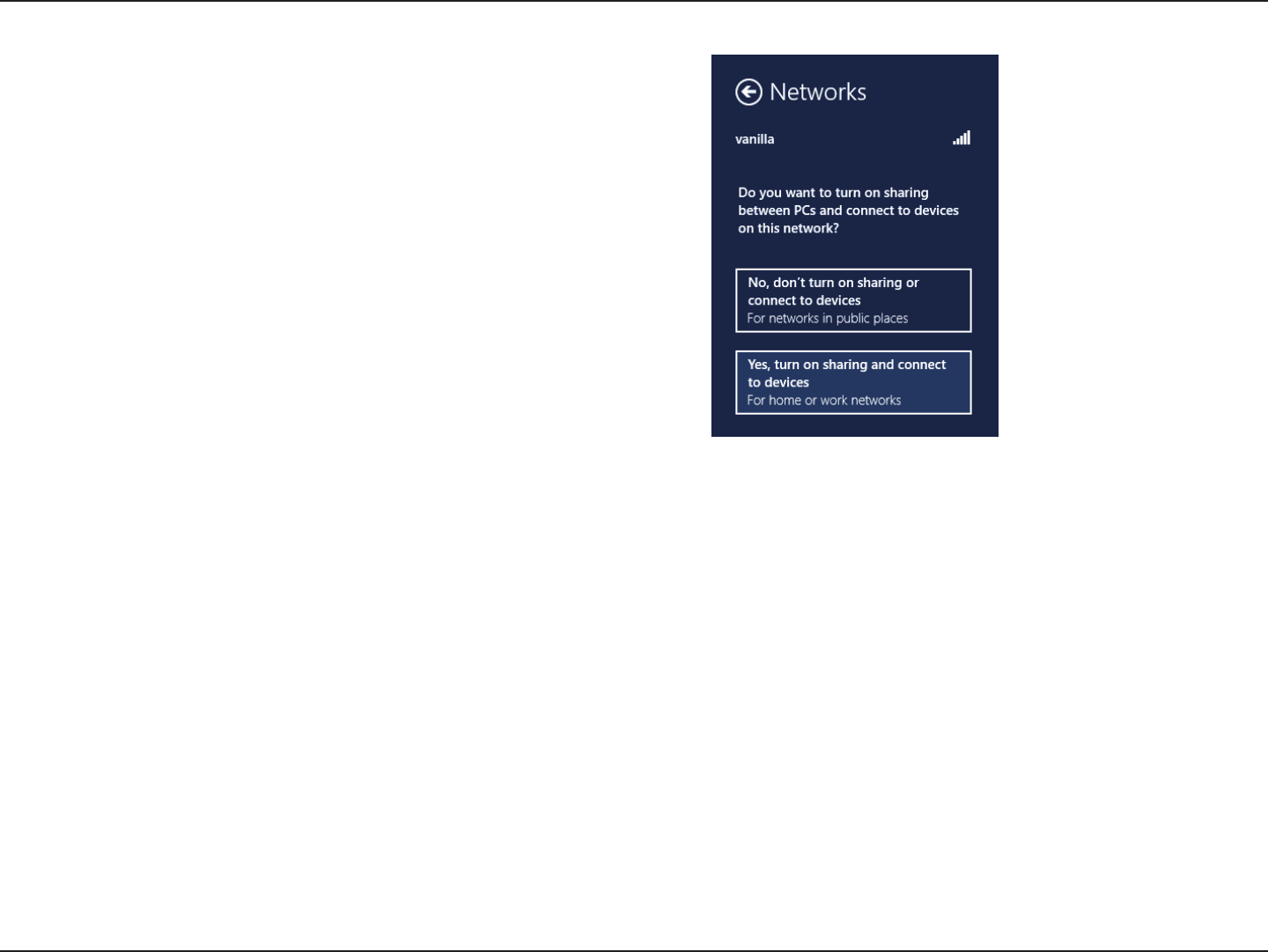
17D-Link DWA-182 User Manual
Section 4 - Connect to a Wireless Network
If you get a good signal but cannot access the Internet, conrm the encryption by reviewing the prole or check the TCP/IP settings for your wireless
adapter. Refer to the Networking Basics section in this manual for more information.
5. Click either to enable or disable le sharing.
6. You will now be connected to your wireless network.

18D-Link DWA-182 User Manual
Section 4 - Connect to a Wireless Network
Windows® 7
Left-click the wireless icon in your system tray (lower-right corner next to
the time).
If you receive the Wireless Networks Detected bubble, click on the center of
the bubble to access the utility.
or
The utility will display any available wireless networks in your area. Click on a
network (displayed using the SSID) and click the Connect button.
If you get a good signal but cannot access the Internet, check your TCP/IP
settings for your wireless adapter. Refer to the Networking Basics section in this
manual for more information.

19D-Link DWA-182 User Manual
Section 5 - Wireless Security
Wireless Security
This section will show you the dierent levels of security you can use to protect your data from intruders. The DWA-182 oers the following types
of security:
• WPA/WPA2-Personal
• WPA/WPA2-Enterprise
What is WPA™?
WPA™, or Wi-Fi® Protected Access, is a Wi-Fi standard that was designed to improve the security features of WEP (Wired Equivalent Privacy).
The 2 major improvements over WEP:
• Improved data encryption through the Temporal Key Integrity Protocol (TKIP). TKIP scrambles the keys using a hashing algorithm
and, by adding an integrity-checking feature, ensures that the keys haven’t been tampered with. WPA2™ is based on 802.11i and
uses Advanced Encryption Standard instead of TKIP.
• User authentication, which is generally missing in WEP, through the extensible authentication protocol (EAP). WEP regulates access
to a wireless network based on a computer’s hardware-specic MAC address, which is relatively simple to be snied out and stolen.
EAP is built on a more secure public-key encryption system to ensure that only authorized network users can access the network.
WPA/WPA2-Personal uses a passphrase or key to authenticate your wireless connection. The key is an alpha-numeric password between 8 and 63
characters long. The password can include symbols (!?*&_) and spaces. This key must be the exact same key entered on your wireless router or
access point.
WPA/WPA2-Enterprise incorporates user authentication through the Extensible Authentication Protocol (EAP). EAP is built on a more secure public
key encryption system to ensure that only authorized network users can access the network.

20D-Link DWA-182 User Manual
Section 6 - Troubleshooting
1. How do I know if my adapter is installed properly?
Click Device Manager.
Troubleshooting
This chapter provides solutions to problems that can occur during the installation and operation of the DWA-182. Read the following descriptions if
you are having problems. The examples below are illustrated in Windows® 7. If you have a dierent operating system, the process on your computer
will be similar.
Go to Start > Computer (right-click) > Properties.
This will bring up the System settings under the Windows Control Panel.
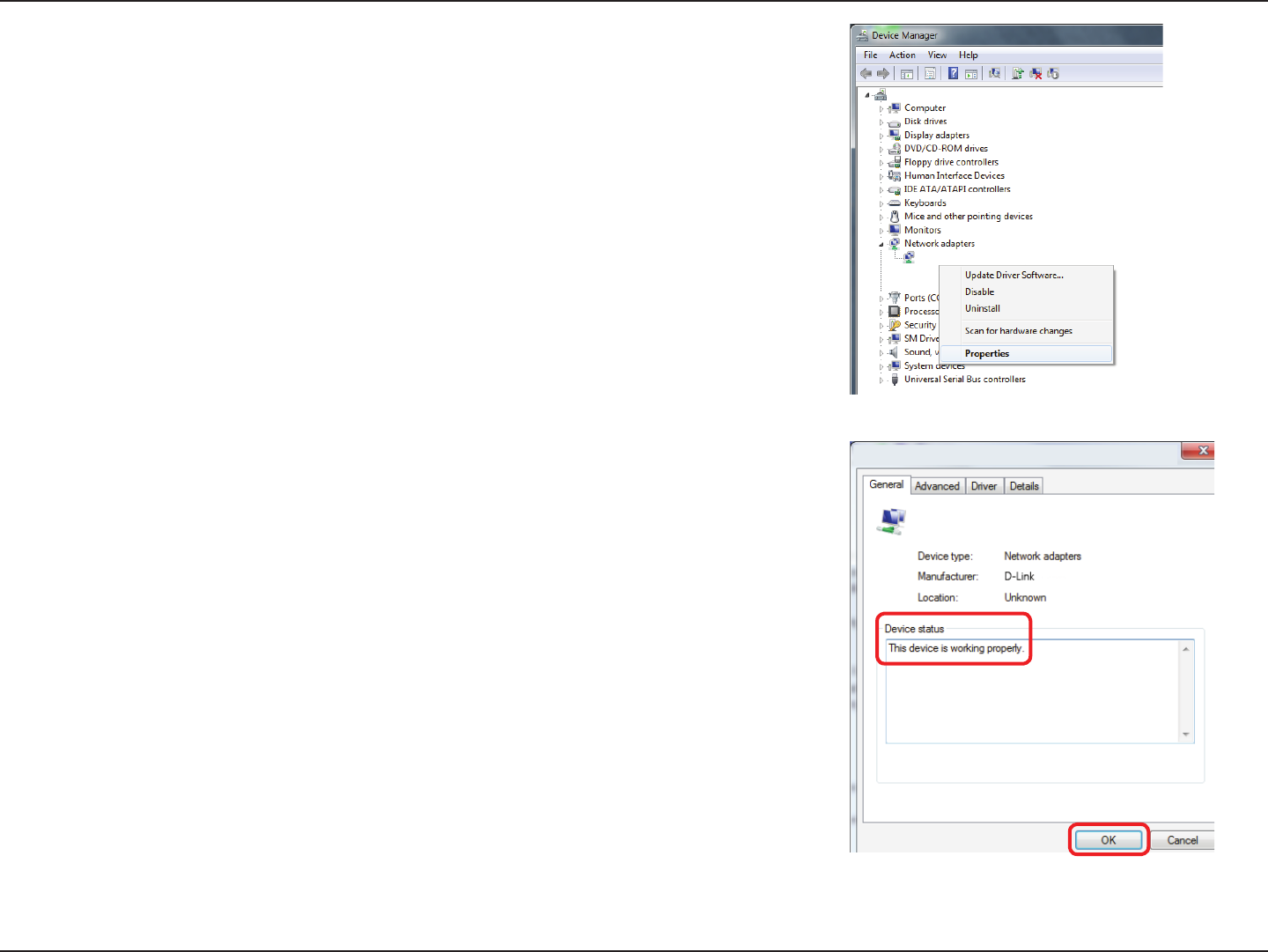
21D-Link DWA-182 User Manual
Section 6 - Troubleshooting
Click the + sign next to Network Adapters.
Right-click on D-Link DWA-182 USB Adapter.
Select Properties to check that the drivers are installed properly.
Look under Device Status to check that the device is working properly. Click OK to continue.
D-Link DWA-182 USB Adapter
D-Link DWA-182
Wireless USB Adapter

22D-Link DWA-182 User Manual
Section 6 - Troubleshooting
Make sure that the DWA-182 AC1200 MU-MIMO Wi-Fi USB Adapter is properly seated in the computer’s USB port.
If Windows does not detect the hardware upon insertion of the adapter, make sure to completely remove drivers that were previously loaded.
2. The computer does not recognize the DWA-182 AC1200 MU-MIMO Wi-Fi USB Adapter.
• Check that the LED indicators for the broadband modem are indicating normal activity. If not, there may be a problem with the
broadband connection.
• Check that the LED indicators on the wireless router are functioning properly. If not, check that the AC power and Ethernet cables
are rmly connected.
• Check that the IP address, subnet mask, gateway, and DNS settings are correctly entered for the network
3. The computer with the DWA-182 installed is unable to connect to the wireless network and/or the Internet.

23D-Link DWA-182 User Manual
Section 6 - Troubleshooting
Check that the Network Connection for the wireless client is congured properly. Select AP (Infrastructure) when connecting to an access point.
Double-click on the WLAN icon in the taskbar > click on Conguration to change the settings for the wireless adapter.
If Security is enabled, make sure that the correct encryption keys are entered on both the DWA-182 and the access point. Double-click on the WLAN
icon in the taskbar > click Encryption. Check to see that the key selected is set to the same key as other devices on the network.

24D-Link DWA-182 User Manual
Appendix A - Wireless Basics
D-Link wireless products are based on industry standards to provide easy-to-use and compatible high-speed wireless connectivity within your
home, business or public access wireless networks. Strictly adhering to the IEEE standard, the D-Link wireless family of products will allow you to
securely access the data you want, when and where you want it. You will be able to enjoy the freedom that wireless networking delivers.
A wireless local area network (WLAN) is a cellular computer network that transmits and receives data with radio signals instead of wires. Wireless
LANs are used increasingly in both home and oce environments, and public areas such as airports, coee shops and universities. Innovative ways
to utilize WLAN technology are helping people to work and communicate more eciently. Increased mobility and the absence of cabling and other
xed infrastructure have proven to be benecial for many users.
Wireless users can use the same applications they use on a wired network. Wireless adapter cards used on laptop and desktop systems support the
same protocols as Ethernet adapter cards.
Under many circumstances, it may be desirable for mobile network devices to link to a conventional Ethernet LAN in order to use servers, printers
or an Internet connection supplied through the wired LAN. A wireless router is a device used to provide this link.
Wireless Basics

25D-Link DWA-182 User Manual
Appendix A - Wireless Basics
What is Wireless?
Wireless or Wi-Fi technology is another way of connecting your computer to the network without using wires. Wi-Fi uses radio
frequency to connect wirelessly, so you have the freedom to connect computers anywhere in your home or oce network.
Why D-Link Wireless?
D-Link is the worldwide leader and award winning designer, developer, and manufacturer of networking products. D-Link
delivers the performance you need at a price you can aord. D-Link has all the products you need to build your network.
How does wireless work?
Wireless works similar to how cordless phone work, through radio signals to transmit data from one point A to point B. But wireless
technology has restrictions as to how you can access the network. You must be within the wireless network range area to be able
to connect your computer. There are two dierent types of wireless networks Wireless Local Area Network (WLAN), and Wireless
Personal Area Network (WPAN).
Wireless Local Area Network (WLAN)
In a wireless local area network, a device called an Access Point (AP) connects computers to the network. The access point has
a small antenna attached to it, which allows it to transmit data back and forth over radio signals. With an indoor access point as
seen in the picture, the signal can travel up to 300 feet. With an outdoor access point the signal can reach out up to 30 miles to
serve places like manufacturing plants, industrial locations, college and high school campuses, airports, golf courses, and many
other outdoor venues.
Wireless Personal Area Network (WPAN)
Bluetooth is the industry standard wireless technology used for WPAN. Bluetooth devices in WPAN operate in a range up to 30
feet away.
Compared to WLAN, the speed and wireless operation range are both less than WLAN, but in return it doesn’t use nearly as much
power which makes it ideal for personal devices, such as mobile phones, PDAs, headphones, laptops, speakers, and other devices
that operate on batteries.

26D-Link DWA-182 User Manual
Appendix A - Wireless Basics
Who uses wireless?
Wireless technology as become so popular in recent years that almost everyone is using it, whether it’s for home, oce, business,
D-Link has a wireless solution for it.
Home
• Gives everyone at home broadband access
• Surf the web, check email, instant message, and etc.
• Gets rid of the cables around the house
• Simple and easy to use
Small Oce and Home Oce
• Stay on top of everything at home as you would at oce
• Remotely access your oce network from home
• Share Internet connection and printer with multiple computers
• No need to dedicate oce space

27D-Link DWA-182 User Manual
Appendix A - Wireless Basics
Where is wireless used?
Wireless technology is expanding everywhere not just at home or oce. People like the freedom of mobility and it’s becoming so popular that
more and more public facilities now provide wireless access to attract people. The wireless connection in public places is usually called “hotspots”.
Using a D-Link USB adapter with your laptop, you can access the hotspot to connect to Internet from remote locations like: airports,
hotels, coee shops, libraries, restaurants, and convention centers.
Wireless network is easy to setup, but if you’re installing it for the rst time it could be quite a task not knowing where to start.
That’s why we’ve put together a few setup steps and tips to help you through the process of setting up a wireless network.
Tips
Here are a few things to keep in mind, when you install a wireless network.
Centralize your router or access point
Make sure you place the router/access point in a centralized location within your network for the best performance. Try to place
the router/access point as high as possible in the room, so the signal gets dispersed throughout your home. If you have a two-
story home, you may need a repeater to boost the signal to extend the range.
Eliminate Interference
Place home appliances such as cordless telephones, Nanowaves, and televisions as far away as possible from the router/access
point. This would signicantly reduce any interference that the appliances might cause since they operate on same frequency.
Security
Don’t let your next-door neighbors or intruders connect to your wireless network. Secure your wireless network by turning on the
WPA or WEP security feature on the router. Refer to product manual for detail information on how to set it up.

28D-Link DWA-182 User Manual
Appendix A - Wireless Basics
There are basically two modes of networking:
• Infrastructure – All wireless clients will connect to an access point or wireless router.
• Ad hoc – Directly connecting to another computer, for peer-to-peer communication, using wireless network adapters on each
computer.
An Infrastructure network contains an access point or wireless router. All the wireless devices, or clients, will connect to the wireless router or access
point.
An ad hoc network contains only clients, such as laptops with wireless USB adapters. All the adapters must be in ad hoc mode to communicate.
Wireless Modes

29D-Link DWA-182 User Manual
Appendix B - Networking Basics
Networking Basics
Check your IP address
After you install your new D-Link wireless adapter and have established a wireless connection, by default, the TCP/IP settings should be set to obtain
an IP address from a DHCP server (i.e. router) automatically. To verify your IP address, please follow the steps below.
• Click Start > All Programs > Accessories > Command Prompt. You may need
administrative access to run this application.
• For all additional prompt windows inquiring of running the command prompt
application, select Ye s, OK, or Continue.
• At the prompt, type ipcong and press Enter.
• This will display the IP address, subnet mask, and default gateway of your adapter.
If the address is 0.0.0.0, check your adapter installation, security settings, and the settings on
your router. Some rewall software programs may block a DHCP request on newly installed
adapters.
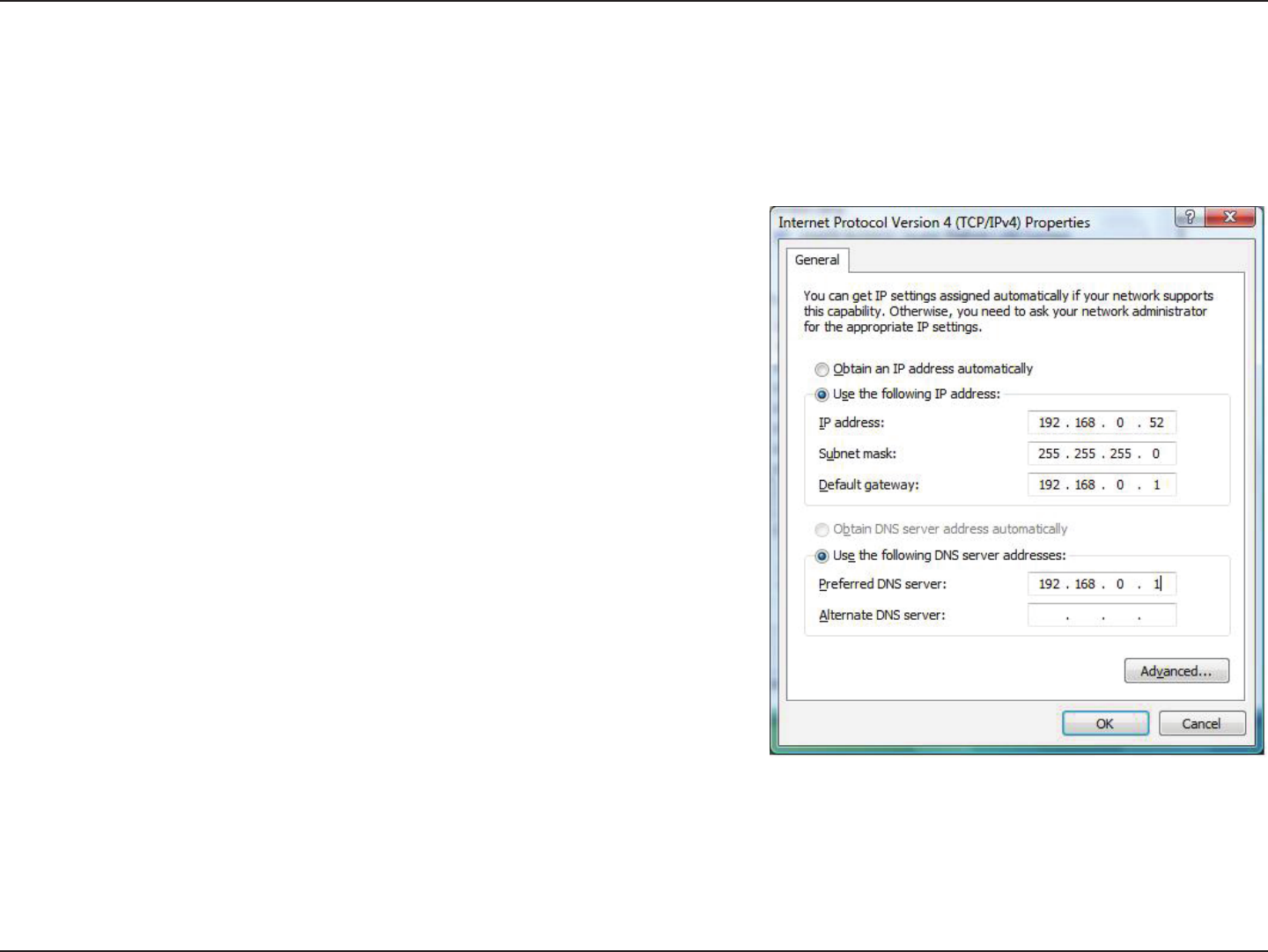
30D-Link DWA-182 User Manual
Appendix B - Networking Basics
Statically Assign an IP address
If you are not using a DHCP capable gateway/router, or you need to assign a static IP address, please follow the steps below:
• Click on Start > Control Panel (make sure you are in Classic View). Double-click
on the Network and Sharing Center icon and then click on Change adapter
settings.
• Right-click on the Local Area Connection which represents your D-Link wireless
network adapter which will be connected to your network.
• Highlight Internet Protocol Version 4 (TCP /IPv4) and click Properties.
• Click Use the following IP address and enter an IP address that is on the same
subnet as your network or LAN IP address on your router or network.
Example: If the router’s LAN IP address is 192.168.0.1, make your IP address
192.168.0.X where X is a number between 2 and 99. Make sure that the number
you choose is not in use on the network.
• Set Default Gateway the same as the LAN IP address of your router or gateway.
• Set Primary DNS the same as the LAN IP address of your router or gateway.
• The Secondary DNS is optional (you may enter a DNS server from your ISP).
• Click OK to save your settings.

31D-Link DWA-182 User Manual
Appendix C - Technical Specications
Technical Specications
Standards
• IEEE 802.11ac
• IEEE 802.11n
• IEEE 802.11g
• IEEE 802.11a
Bus Type
• USB 3.0 or USB 2.0
Security
• Wi-Fi Protected Access (WPA™ & WPA2™)
• Wi-Fi Protected Setup - PIN & PBC
Current Consumption (802.11n)
• Tx: 150mA
• Rx: 150mA
Operating Voltage
• 5.0 VDC +/- 10%
Operating Temperature
• 32°F to 104°F ( 0°C to 40°C)
Operating Humidity
• 10% to 90% maximum (non-condensing)
Dimensions
• 97x19x12 mm (3.82x0.75x0.47 inches)
Weight
• 15.65 grams
Certications
• FCC Class B
• CE
• C-Tick
• IC
* Maximum wireless signal rate derived from IEEE Standard 802.11ac, 802.11n and 802.11g specications. Actual data throughput will vary. Network conditions
and environmental factors, including volume of network trac, building materials and construction, and network overhead, lower actual data throughput rate.
Environmental factors will adversely aect wireless signal range.

32D-Link DWA-182 User Manual
Appendix D - Warranty
Warranty
Federal Communication Commission Interference Statement
This device complies with Part 15 of the FCC Rules. Operation is subject to the following two conditions: (1) This device may not cause harmful
interference, and (2) this device must accept any interference received, including interference that may cause undesired operation.
This equipment has been tested and found to comply with the limits for a Class B digital device, pursuant to Part 15 of the FCC Rules. These limits are
designed to provide reasonable protection against harmful interference in a residential installation. This equipment generates, uses and can radiate
radio frequency energy and, if not installed and used in accordance with the instructions, may cause harmful interference to radio communications.
However, there is no guarantee that interference will not occur in a particular installation. If this equipment does cause harmful interference to radio
or television reception, which can be determined by turning the equipment o and on, the user is encouraged to try to correct the interference by
one of the following measures:
• Reorient or relocate the receiving antenna.
• Increase the separation between the equipment and receiver.
• Connect the equipment into an outlet on a circuit dierent from that to which the receiver is connected.
• Consult the dealer or an experienced radio/TV technician for help.
FCC Caution:
• Any changes or modications not expressly approved by the party responsible for compliance could void the user’s authority to operate this
equipment.
• This transmitter must not be co-located or operating in conjunction with any other antenna or transmitter.
Radiation Exposure Statement:
This device meets the government’s requirements for exposure to radio waves.
This device is designed and manufactured not to exceed the emission limits for exposure to radio frequency (RF) energy set by the Federal
Communications Commission of the U.S. Government.
The exposure standard for wireless device employs a unit of measurement known as the Specic Absorption Rate, or SAR. The SAR limit set by
the FCC is 1.6W/kg. *Tests for SAR are conducted using standard operating positions accepted by the FCC with the device transmitting at its
highest certied power level in all tested frequency bands.
Note: The country code selection is for non-US model only and is not available to all US model. Per FCC regulation, all WiFi product marketed in
US must xed to US operation channels only.

33D-Link DWA-182 User Manual
Appendix D - Warranty
Industry Canada statement
1. This device complies with Industry Canada license-exempt RSS standard(s). Operation is subject to the following two conditions:
1) this device may not cause interference, and
2) this device must accept any interference, including interference that may cause undesired operation of the device.
1. Le présent appareil est conforme aux CNR d’Industrie Canada applicables aux appareils radio exempts de licence. L’exploitation est autorisée
aux deux conditions suivantes:
1) l’appareil ne doit pas produire de brouillage, et
2) l’utilisateur de l’appareil doit accepter tout brouillage radioélectrique subi, même si le brouillage est susceptible d’en compromettre le
fonctionnement.
2. This Class B digital apparatus complies with Canadian ICES-003.
2. Cet appareil numérique de la classe B est conforme à la norme NMB-003 du Canada.
3. This device and its antenna(s) must not be co-located or operating in conjunction with any other antenna or transmitter, except tested built-in
radios.
3. Cet appareil et son antenne ne doivent pas être situés ou fonctionner en conjonction avec une autre antenne ou un autre émetteur, exception
faites des radios intégrées qui ont été testées.
4. The County Code Selection feature is disabled for products marketed in the US/ Canada.
4. La fonction de sélection de l’indicatif du pays est désactivée pour les produits commercialisés aux États-Unis et au Canada.
Radiation Exposure Statement:
The product comply with the Canada portable RF exposure limit set forth for an uncontrolled environment and are safe for intended operation as
described in this manual. The further RF exposure reduction can be achieved if the product can be kept as far as possible from the user body or set
the device to lower output power if such function is available.
Déclaration d’exposition aux radiations:
Le produit est conforme aux limites d’exposition pour les appareils portables RF pour les Etats-Unis et le Canada établies pour un environnement
non contrôlé.
Le produit est sûr pour un fonctionnement tel que décrit dans ce manuel. La réduction aux expositions RF peut être augmentée si l’appareil peut
être conservé aussi loin que possible du corps de l’utilisateur ou que le dispositif est réglé sur la puissance de sortie la plus faible si une telle fonction
est disponible.

34D-Link DWA-182 User Manual
Appendix D - Warranty
Caution :
1) the device for operation in the band 5150-5250 MHz is only for indoor use to reduce the potential for harmful interference to co-channel mobile
satellite systems;
2) the maximum antenna gain permitted for devices in the bands 5250-5350 MHz and 5470-5725 MHz shall comply with the e.i.r.p. limit; and
3) the maximum antenna gain permitted for devices in the band 5725-5825 MHz shall comply with the e.i.r.p. limits specied for point-to-point
and non point-to-point operation as appropriate.
4) the worst-case tilt angle(s) necessary to remain compliant with the e.i.r.p. elevation mask requirement set forth in Section 6.2.2(3) shall be clearly
indicated.
5) Users should also be advised that high-power radars are allocated as primary users (i.e. priority users) of the bands 5250-5350 MHz and 5650-
5850 MHz and that these radars could cause interference and/or damage to LE-LAN devices.
Avertissement:
1) les dispositifs fonctionnant dans la bande 5150-5250 MHz sont réservés uniquement pour une utilisation à l’intérieur an de réduire les risques
de brouillage préjudiciable aux systèmes de satellites mobiles utilisant les mêmes canaux;
2) le gain maximal d’antenne permis pour les dispositifs utilisant les bandes 5250-5350 MHz
et 5470-5725 MHz doit se conformer à la limite de p.i.r.e.;
3) le gain maximal d’antenne permis (pour les dispositifs utilisant la bande 5725-5825 MHz) doit se conformer à la limite de p.i.r.e. spéciée pour
l’exploitation point à point et non point à point, selon le cas.
4) les pires angles d’inclinaison nécessaires pour rester conforme à l’exigence de la p.i.r.e. applicable au masque d’élévation, et énoncée à la section
6.2.2 3), doivent être clairement indiqués.
5) De plus, les utilisateurs devraient aussi être avisés que les utilisateurs de radars de haute puissance sont désignés utilisateurs principaux (c.-à-d.,
qu’ils ont la priorité) pour les bandes 5250-5350 MHz
et 5650-5850 MHz et que ces radars pourraient causer du brouillage et/ou des dommages aux dispositifs LAN-EL.